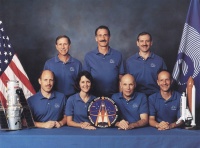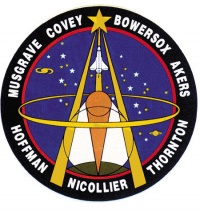STS-61
From The Space Library
 | |
| Organization | NASA-Office of Space Flight (United States) |
|---|---|
| Mission type | Human Crew |
| Launch date | December 2, 1993 |
| Launch vehicle | Space Shuttle |
| Launch site | Cape Canaveral, United States |
| COSPAR ID | 1993-075A |
| Inclination | 28.45 degrees |
| Experiments | Here |
| Alternate Names | 22917 |
| Additional Information | Here |
| PDMP Information | Here |
| Telecommunications Information | Here |
| Data Collection | Here |
| Payload Mass Up | 8011 kg |
| Payload Mass Down | 8028.18 kg |
| Orbiter | Endeavour |
| Lift Off Mass | 2,052,340.91 kg |
| Orbiter Weight at Liftoff | 113,779.09 kg |
| Orbiter Weight at Landing | 96,004.55 kg |
| Landed | Concrete runway 33 at Kennedy Space Center, Fla. |
| Orbits of Earth | 163 |
| Orbital Altitude | 311 nautical miles (358 statute miles) |
Contents |
[edit] Crew
- Commander: Richard O. Covey
- Pilot: Kenneth Bowersox
- Payload Commander: F. Story Musgrave
- Mission Specialist 1: Thomas D. Akers
- Mission Specialist 2: Jeffrey A. Hoffman
- Mission Specialist 3: Kathryn C. Thornton
- Mission Specialist 4:
- Mission Specialist 5:
- Payload Specialist 1: Claude Nicollier, European Space Agency
- Payload Specialist 2:
ISS/Mir Crew Transport
[edit] Mission
STS 61 was the fifth flight of the Endeavour orbiter and the 59th shuttle mission. Its objective was to repair, replace, and/or update the instruments on the Hubble Space Telescope. During several days of EVA, the crew installed corrective optics (COSTAR) in the light path after removing the High Speed Photometer (HSP) instrument; replaced the older Wide Field/Planetary Camera (WF/PC) with a newer version (WFPC 2); and replaced malfunctioning solar arrays. The duration of the mission was 10 days, 19 hours, 58 minutes, and 37 seconds and lasted for 163 orbits.
[edit] EVA
Extravehicular Activity (EVA) conducted by Story Musgrave, Jeffrey Hoffman, Thomas Akers, and Kathryn Thornton during five spacewalks for a total of 35 hours, 28 minutes. EVA 1, Musgrave and Hoffman, 7 hours, 54 minutes; Musgrave and Hoffman successfully changed out Hubble's rate sensing units and electronics control unit and eight fuse plugs. EVA 2, Akers and Thornton, 6 hours, 36 minutes; Akers and Thornton installed two new solar arrays and jettisoned one of Hubble's original solar arrays, which was bent. EVA 3, Musgrave and Hoffman, 6 hours, 47 minutes; Musgrave and Hoffman removed and stored the telescope's original wide-field/planetary camera and installed the replacement Wide-Field/Planetary Camera II and two new magnetometers. EVA 4, Akers and Thornton, 6 hours, 50 minutes; Akers and Thornton removed the telescope's high-speed photometer and installed the corrective optics space telescope axial replacement unit and a new computer coprocessor. EVA 5, Musgrave and Hoffman, 7 hours, 21 minutes; Musgrave and Hoffman replaced the telescope's solar array drive electronics and installed the Goddard high-resolution spectrograph redundancy kit and two Mylar covers over the original magnetometers to contain any contamination or debris that might come off the instrument and protect it from ultraviolet degradation.
[edit] Payload
Hubble Space Telescope (HST) Servicing Mission (SM) 1; IMAX Camera; IMAX Cargo Bay Camera (ICBC); Air Force Maui Optical Site (AMOS)
[edit] Books about the Space Shuttle Program
Buy This Book Click here |
Buy This Book here |
Buy This Book Click here |
Buy This Book Click here |





